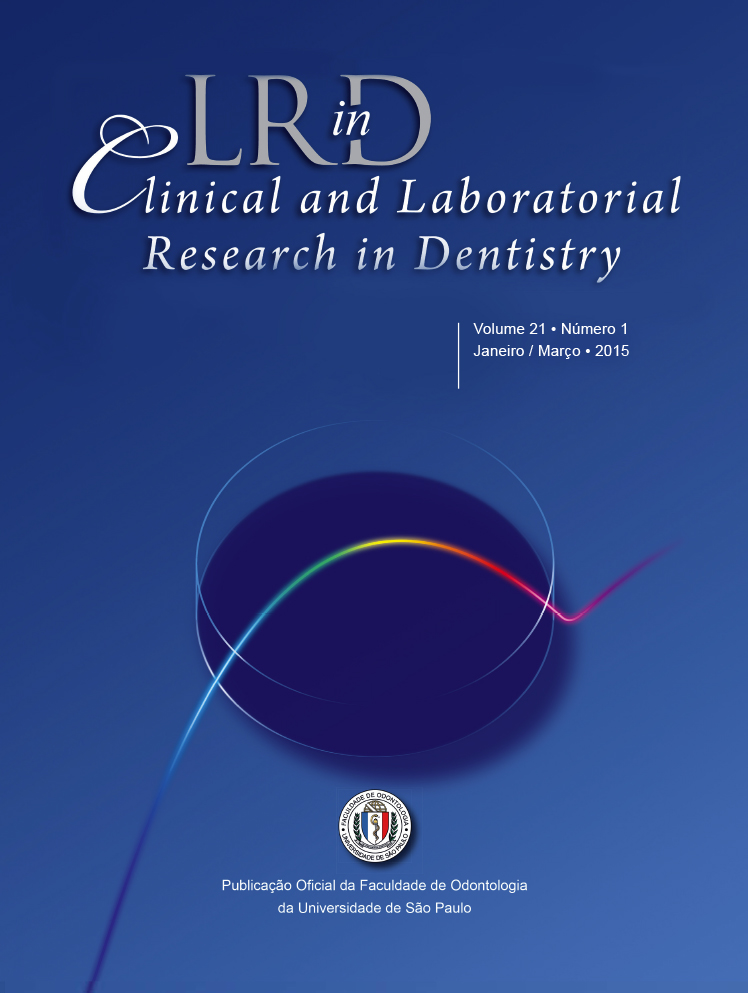Unilateral condylar hyperplasia: evaluation of 6 cases
DOI:
https://doi.org/10.11606/issn.2357-8041.clrd.2015.90855Keywords:
hyperplasia, facial asymmetry, mandibular condyleAbstract
This study aimed to report six cases of unilateral condylar hyperplasia (CH), regarding their demographic and clinical characteristics and imaging and histopathological findings. Sex, age, affected side, history of the case, complementary examinations and treatment were recorded. Five cases (83.3%) were females and the mean age of the study population was 19.3 years (range: 14-28 years). The right condyle was affected in 4 cases (66.6%). Five (83.3%) patients were subjected to condylotomy, and high condylectomy was done in 1 (16.6%) case. The patients were followed up postoperatively for a mean period of 27.5 months. All patients received surgical and orthodontic treatment. In the present study, CH occurred more frequently in the first decades of life and it was more prevalent in females. The right condyle was more affected than the left one and condylotomy combined with orthodontics was the main treatment performed.
Downloads
References
Mehrotra D, Dhasmana S, Kamboj M, Gambhir G. Condylar hyperplasia and facial asymmetry: report of five cases. J Maxillofac Oral Surg. 2011 Mar;10(1): 50-56.
Eslami B, Behnia H, Javadi H, Khiabani KS, Saffar AS. Histopathologic comparison of normal and hyperplastic condyles. Oral Surg Oral Med Oral Pathol Oral Radiol Endod. 2003 Dec;96(6):711-717.
Sugawara Y, Hirabayashi S, Susami T, Hiyama S. The treatment of hemimandibular hyperplasia preserving enlarged condylar head. Cleft Palate Craniofac J. 2002 Nov;39(6):646-654.
Raijmakers PG, Karssemakers LH, Tuinzing DB. Female predominance and effect of gender on unilateral condylar hyperplasia: a review and meta-analysis. J Oral Maxillofac Surg. 2012 Jan;70(1):e72-e76.
Matteson SR, Proffit WR, Terry BC, Staab EV, Burkes EJ Jr. Bone scanning with 99mtechnetium phosphate to assess condylar hyperplasia. Report of two cases. Oral Surg Oral Med Oral Pathol. 1985 Oct;60(4):356-367.
Shintaku WH, Venturin JS, Langlais RP, Clark GT. Imaging modalities to access bony tumors and hyperplasic reactions of the temporomandibular joint. J Oral Maxillofac Surg. 2010 Aug;68(8):1911-1912.
Laverick S, Bounds G, and Wong WL. [18F]-fluoride positron emission tomography for imaging condylar hyperplasia. Br J Oral Maxillofac Surg. 2009 Apr;47(3):196-199.
Verhoeven TJ, Nolte JW, Maal TJ, Bergé SJ, Becking AG. Unilateral condylar hyperplasia: a 3-dimensional quantification of asymmetry. PLoS One. 2013 Mar;8(3):e59391.
Yang J, Lignelli JL, Ruprecht A. Mirror image condylar hyperplasia in two siblings. Oral Surg Oral Med Oral Pathol Oral Radiol Endod. 2004 Feb;97(2):281-285.
Fariña RA, Becar M, Plaza C, Espinoza I, Franco ME. Correlation between single photon emission computed tomography, AgNOR count, and histomorphologic features in patients with active mandibular condylar hyperplasia. J Oral Maxillofac Surg. 2011 Feb;69(2):356-361.
Jones RH and Tier GA. Correction of facial asymmetry as a result of unilateral condylar hyperplasia. J Oral Maxillofac Surg. 2012 Jun;70(6):1413-1425.
Cervelli V, Bottini DJ, Arpino A, Trimarco A, Cervelli G, Mugnaini F. Hypercondylia: problems in diagnosis and therapeutic indications. J Craniofac Surg. 2008 Mar;19(2):406-410.
Wolford LM, Morales-Ryan CA, García-Morales P, Perez D. Surgical management of mandibular condylar hyperplasia type 1. Proc (Bayl Univ Med Cent). 2009 Oct;22(4):321-329.
Nitzan DW, Katsnelson A, Bermanis I, Brin I, Casap N. The clinical characteristics of condylar hyperplasia: experience with 61 patients. J Oral Maxillofac Surg. 2008 Feb;66(2):312-318.
Villanueva-Alcojol L, Monje F, González-García R. Hyperplasia of the mandibular condyle: clinical, histopathologic, and treatment considerations in a series of 36 patients. J Oral Maxillofac Surg. 2011 Feb;69(2):447-455.
Chepla KJ, Cachecho C, Hans MG, Gosain AK. Use of intraoral miniplates to control postoperative occlusion after high condylectomy for the treatment of condylar hyperplasia. J Craniofac Surg. 2012 Mar;23(2):406-409.
Gray RJ, Sloan P, Quayle AA, Carter DH. Histopathological and scintigraphic features of condylar hyperplasia. Int J Oral Maxillofac Surg. 1990 Apr;19(2):65-71.
Muñoz MF, Monje F, Goizueta C, Rodríguez-Campo F. Active condylar hyperplasia treated by high condylectomy: report of case. J Oral Maxillofac Surg. 1999 Dec;57(12):1455-1459.
Gc R, Muralidoss H, Ramaiah S. Conservative management of unilateral condylar hyperplasia. Oral Maxillofac Surg. 2012 Jun;16(2):201-205.
Saridin CP, Raijmakers P, Becking AG. Quantitative analysis of planar bone scintigraphy in patients with unilateral condylar hyperplasia. Oral Surg Oral Med Oral Pathol Oral Radiol Endod. 2007 Aug;104(2):259-263.
Slootweg PJ and Müller H. Condylar hyperplasia. A clinico-pathological analysis of 22 cases. J Maxillofac Surg. 1986 Aug;14(4):209-214.
Lippold C, Kruse-Losler B, Danesh G, Joos U, Meyer U. Treatment of hemimandibular hyperplasia: the biological basis of condylectomy. Br J Oral Maxillofac Surg. 2007 Jul;45(5):353-360.
Ferreira S, da Silva Fabris AL, Ferreira GR, Faverani LP, Francisconi GB, Souza FA et al., Unilateral condylar hyperplasia: a treatment strategy. J Craniofac Surg. 2014 May;23(3):e256-8.
Wolford LM, Movahed R, Perez DE. A classification system for conditions causing condylar hyperplasia. J Oral Maxillofac Surg. 2014 Mar;72(3):567-95
Downloads
Published
Issue
Section
License
Authors are requested to send, together with the letter to the Editors, a term of responsibility. Thus, the works submitted for appreciation for publication must be accompanied by a document containing the signature of each of the authors, the model of which is presented as follows:
I/We, _________________________, author(s) of the work entitled_______________, now submitted for the appreciation of Clinical and Laboratorial Research in Dentistry, agree that the authors retain copyright and grant the journal right of first publication with the work simultaneously licensed under a Creative Commons Attribution License that allows others to share the work with an acknowledgement of the work's authorship and initial publication in this journal. Authors are able to enter into separate, additional contractual arrangements for the non-exclusive distribution of the journal's published version of the work (e.g., post it to an institutional repository or publish it in a book), with an acknowledgement of its initial publication in this journal. Authors are permitted and encouraged to post their work online (e.g., in institutional repositories or on their website) prior to and during the submission process, as it can lead to productive exchanges, as well as earlier and greater citation of published work (See The Effect of Open Access).
Date: ____/____/____Signature(s): _______________


